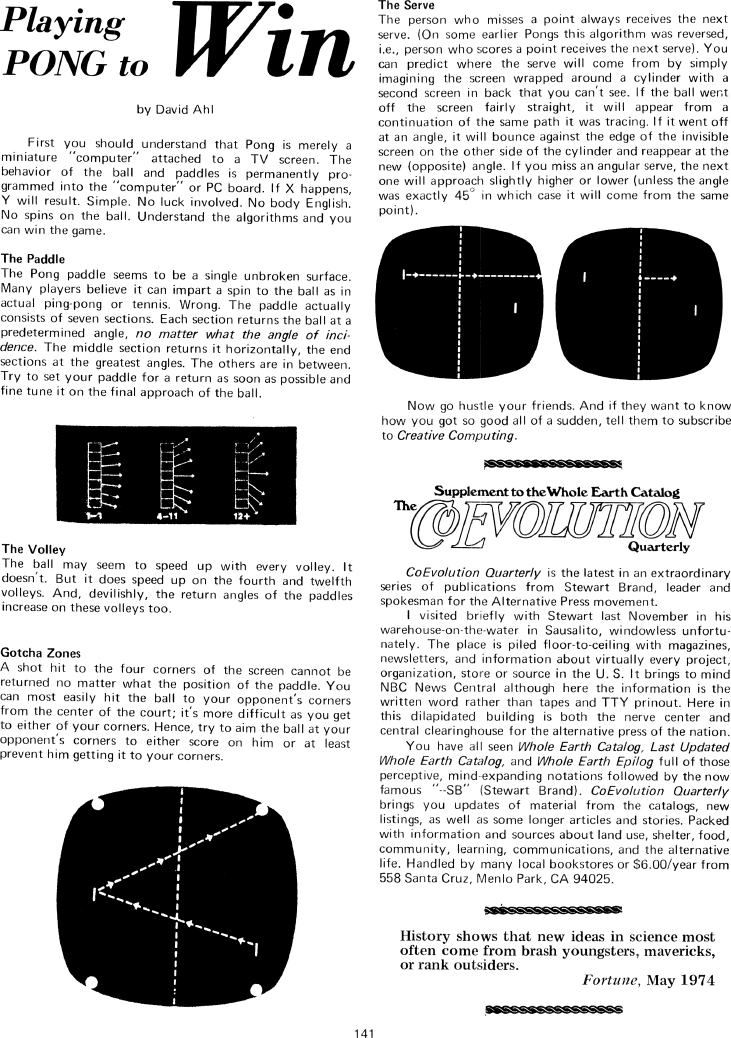The Best of Creative Computing Volume 1 (published 1976)
Playing PONG to Win (tips for winning Atari PONG)

Playing PONG to Win
by David Ahl
First you should understand that Pong is merely a miniature "computer" attached
to a TV screen, The behavior of the ball and paddles is permanently programmed
into the "computer" or PC board. If X happens, Y will result. Simple. No luck
involved. No body English. No spins on the ball. Understand the algorithms and
you can win the game.
The Paddle
The Pong paddle seems to be a single unbroken surface. Many players believe it
can impart a spin to the ball as in actual ping-pong or tennis. Wrong. The
paddle actually consists of seven sections. Each section returns the ball at a
predetermined angle, no matter what the angle of incidence. The middle section
returns it horizontally, the end sections at the greatest angles. The others are
in between. Try to set your paddle for a return as soon as possible and fine
tune it on the final approach of the ball.
[image]
The Volley
The ball may seem to speed up with every volley. It doesn’t. But it does speed
up on the fourth and twelfth volleys, And, devilishly, the return angles of the
paddles increase on these volleys too.
Gotcha Zones
A shot hit to the four corners of the screen cannot be returned no matter what
the position of the paddle. You can most easily the ball to your opponent’s
corners from the center of the court; it's more difficult as you get to either
of your corners. Hence, try to aim the ball at your opponent's corners to either
score on him or at least prevent him getting it to your corners.
[image]
The Serve
The person who misses a point always receives the next serve, (On some earlier
Pongs this algorithm was reversed, i.e., person who scores a point receives the
next serve). You can predict where the serve will come from by simply imagining
the screen wrapped around a cylinder with a second screen in back that you can't
see. If the ball went off the screen fairly straight, it will appear from a
continuation of the same path it was tracing, If it went off at an angle, it
will bounce against the edge of the invisible screen on the other side of the
cylinder and reappear at the new (opposite) angle. lf you miss an angular serve,
the next one will approach slightly higher or lower (unless the angle was
exactly 45° in which case it will come from the same point).
[image]
Now go hustle your friends. And if they want to know how you got so good all of
a sudden, tell them to subscribe to Creative Computing.
[image]
Supplement to the Whole Earth Catalog
The CoEVOLUTION
Quarterly
CoEvolution Quarterly is the latest in an extraordinary series of publications
from Stewart Brand, leader and spokesman for the Alternative Press movement.
I visited briefly with Stewart last November in his warehouse-on-the-water in
Sausalito, windowless unfortunately. The place is piled floor-to-ceiling with
magazines, newsletters, and information about virtually every project,
organization, store or source in the U. S. lt brings to mind NBC News Central
although here the information is the written word rather than tapes and TTY
prinout, Here in this dilapidated building is both the nerve center and central
clearinghouse for the alternative press of the nation.
You have all seen Whole Earth Catalog, Last Updated Whole Earth Catalog, and
Whole Earth Epilog full of those perceptive, mind-expanding notations followed
by the now famous "--SB" (Stewart Brand). CoEvolution Quarterly brings you
updates of material from the catalogs, new listings, as well as some longer
articles and stories. Packed with information and sources about land use,
shelter, food, community, learning, communications, and the alternative life.
Handled by many local bookstores or $6.00/year from 558 Santa Cruz, Menlo Park,
CA 94025.
[image]
History shows that new ideas in science most often come from brash youngsters,
mavericks, or rank outsiders.
Fortune, May 1974
[image]
141


